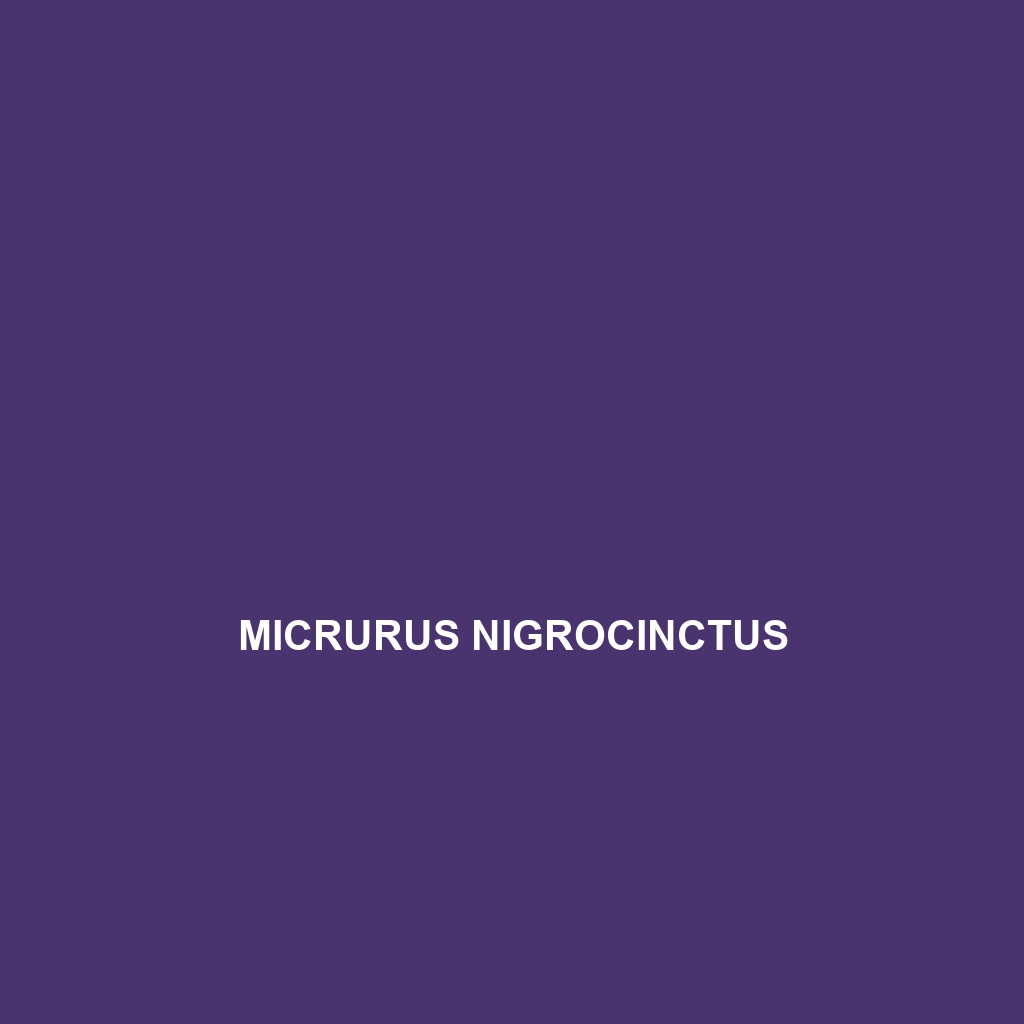Common Name
Micrurus nigrocinctus
Scientific Name
Micrurus nigrocinctus
Habitat
Micrurus nigrocinctus, commonly known as the black-striped coral snake, is primarily found in the tropical and subtropical regions of Central and South America. Its habitat encompasses a variety of ecosystems including rainforests, savannas, and occasionally temperate forests. These snakes thrive within moist environments, typically favoring areas rich in leaf litter, under logs, and in dense vegetation, where they can easily camouflage and hunt for prey. The climate in these regions is generally humid, with warm temperatures year-round, providing ideal conditions for the survival of this elusive species.
Physical Characteristics
The Micrurus nigrocinctus can be easily distinguished by its striking physical characteristics. Adult individuals typically reach a length of 60 to 90 cm (2 to 3 feet), exhibiting a slender, elongated body structure. The coloration is predominantly black with distinctive yellow or white banding that encircles the body, giving it a unique and recognizable appearance. This color pattern serves both as a warning to potential predators and as camouflage in its natural habitat. Additionally, the head of the black-striped coral snake is small and features small, smooth scales, which add to its streamlined appearance.
Behavior
In terms of behavior, Micrurus nigrocinctus is primarily a nocturnal species, becoming active during the night when it hunts for prey. During the day, these snakes tend to be reclusive, hiding under debris or within the leaf litter to avoid detection. They exhibit interesting mating rituals, often engaging in complex courtship displays where males will perform movements to attract females. Socially, these snakes are solitary creatures, coming together only during the breeding season. Their elusive nature and reclusive habits make them difficult to study, but they are primarily ground dwellers, providing an earthbound setting for much of their activity.
Diet
The diet of Micrurus nigrocinctus consists mainly of other small reptiles and amphibians, qualifying it as a carnivore. This snake employs a strategy called chemosensory hunting, using its forked tongue to detect chemical signals left by potential prey. Its primary food sources include lizards and small frogs, which it immobilizes using its potent venom before consumption. This dietary preference makes it an important predator within its ecosystem, maintaining the balance by controlling the populations of these smaller reptiles.
Reproduction
The reproductive cycle of Micrurus nigrocinctus typically occurs during the warmer months, aligning with the rainy season when food availability is heightened. Mating usually takes place in the spring, followed by a gestation period of around 4 to 6 weeks. Females are ovoviviparous, meaning they bear live young rather than laying eggs. A single litter can consist of approximately 5 to 10 offspring, which are independent from birth and receive no parental care. As they mature, these juvenile snakes develop their characteristic coloration and begin hunting for themselves shortly after birth.
Conservation Status
Currently, the conservation status of Micrurus nigrocinctus is classified as Least Concern according to the IUCN Red List. Despite having a stable population in certain areas, habitat destruction due to deforestation, agricultural expansion, and urbanization poses ongoing threats. Conservation efforts are focusing on habitat preservation and awareness to mitigate these dangers. Local initiatives aim to educate communities about the role of coral snakes in biodiversity, helping to foster a coexistence that will support this species’ survival.
Interesting Facts
One fascinating aspect of Micrurus nigrocinctus is its potent venom, which is neurotoxic, able to cause paralysis and respiratory failure in its prey. However, this snake is not aggressive toward humans and will typically avoid confrontation unless provoked. Furthermore, its coloration mimics other venomous species, serving as a form of mimicry that protects it from predators, a common survival strategy among coral snakes. Studies also suggest that these snakes may exhibit slight variations in coloration across different regions, highlighting the adaptability and diversity of the species.
Role in Ecosystem
The Micrurus nigrocinctus plays a vital role in its ecosystem as a predator of smaller reptiles and amphibians, helping to keep their populations in check. This predatory behavior helps maintain the overall health of the ecosystem, contributing to biodiversity. Additionally, as a prey item for larger predatory species, it fits into the broader food web, emphasizing its importance in the ecological balance. By participating in the intricate interactions of its habitat, the black-striped coral snake aids in sustaining the environment’s natural processes.
